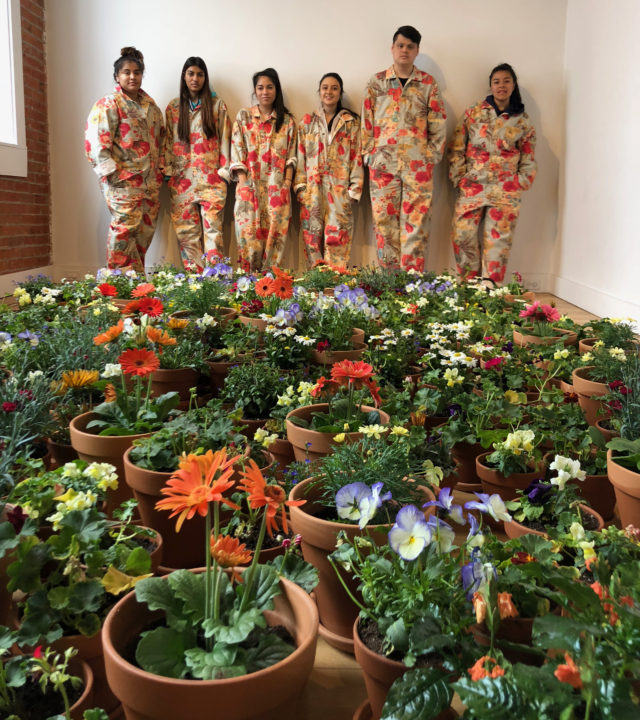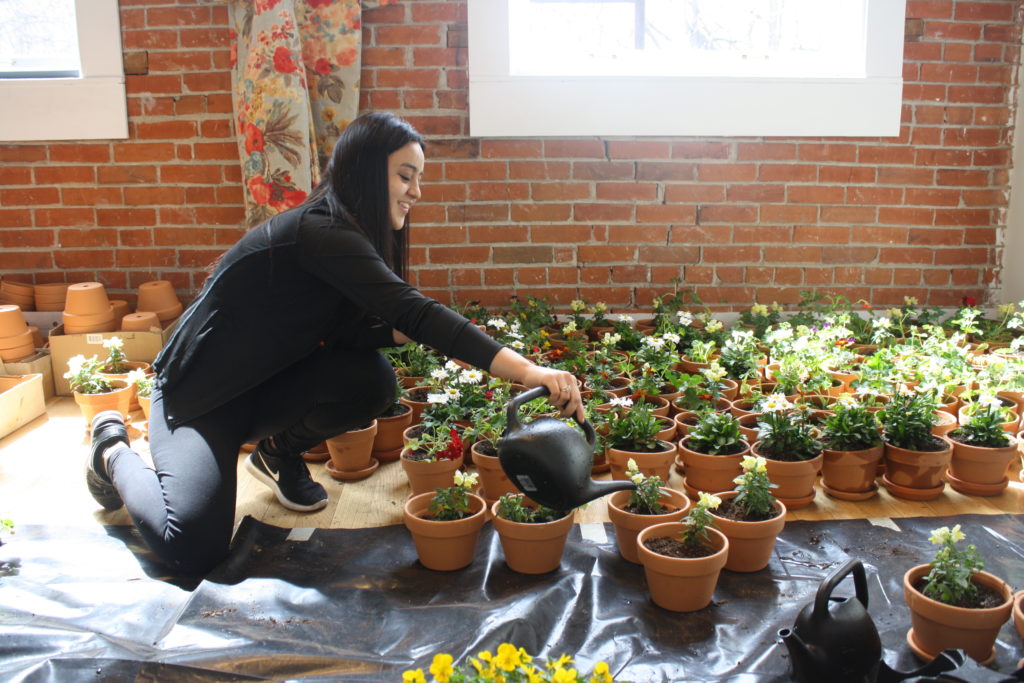
There’s an earthiness in the air as several young people work on potting some 300 flowers in the lobby of the Boulder Museum of Contemporary Art. “I think we need some blue,” says artist Patty Ortiz, looking over the crop of white, pink, yellow and red. She’s in the process of installing her latest exhibit, Work Won’t Kill You: I am Here, a performance art piece highlighting the stories and experiences of Deferred Action for Childhood Arrivals (DACA) recipients.
An Obama-era program that provides deportation relief and work authorization for 800,000 young people who were brought to the U.S. as children, DACA has faced uncertainty in the last year. The Trump administration intends to terminate the program, but federal judges have ordered it remains intact until legal challenges can make their way through the courts. At the same time, Congress has failed to find consensus on immigration reform and pass legislation to protect these young people.
“With the recent developments that have been happening at the federal level and the quandary that these involuntary childhood immigrants are facing these days, … we felt it was an opportunity for us to present their perspectives and be a platform to raise awareness about their issues,” says BMoCA Executive Director David Dadone. “And that’s where we as a contemporary art museum can really make an impact in our community and beyond — by presenting the facts and their point of view through an installation and art performance and present them to the community.”
I am Here was commissioned by BMoCA as part of its Present Box exhibition series, which, since 2011, has transformed the museum’s small lobby a few times a year into a piece of performance art.
It’s fifth in Ortiz’ exhibition series Work Won’t Kill You, inspired by a quote her father often said: “Work won’t kill you, laziness will.”
“Work can be anything; it’s really just exerting some kind of force forward,” Ortiz says. “Work is the great unifier.”
In all of her installation work, Ortiz hires locals to engage in the project. In Syracuse, New York, she gathered unemployed and retired men living in poverty to systematically examine images from their community in a work of forensic art. In San Diego, she employed workers to catalog the commercial exchanges taking place every day in a retail corridor.
“Working together, it becomes this community and there does become this connection and relationship that we have now from all of the time we spent together,” she says. “That’s part of the piece for me.”

For I am Here, Ortiz has hired nine DACA recipients who grew up in Boulder County, ranging in age from 18-27, to care for the potted plants in the museum’s lobby. Ortiz designed bright, flowered jumpsuits — uniforms, if you will — for the young people to wear as they work.
“They will make sure the plants are growing and water the flowers,” Ortiz says. “The other thing they can do, which I think is more exciting, is they get to arrange the flowers any way they want. I’ll arrange them first and then after that it’s up to them. They can arrange it by color, they can arrange it by kind, they can arrange it by design. It’s really up to them.”
While the workers arrange pots and care for the flowers, a projected video will loop behind them. A collage of moving flowers flashes on the screen with a voiceover of the students sharing their stories.
“I remember it being wet because we had to cross through the river,” one girl says. “I was wearing these shoes that they made over there that smell like oranges.”
“I do not have any memories before I came to the United States,” someone else adds. “I want to repay my parents for all their sacrifices they’ve done for me and my sister to give us a better life.”
Every minute the video cuts to a slow moving hand traveling from the left of the screen toward a potted plant sitting on the right. Eventually the fingers grasps the stem, right beneath the flowers, in a tight fist, uprooting it in one swift jerk as soil flies out of the pot in slow motion.
“My feeling was this idea of pulling a plant out of a pot, out of the ground, and not only seeing the roots being pulled away from [the soil] but also the hole that is left,” Ortiz says.
Starting with this initial concept, Ortiz gathered the group around the museum’s conference table to share their experiences. For some, it was the first time they had ever talked publicly about their status.
“I never really shared my story until now,” says Itzel, 27, a DACA recipient who was raised in Boulder and heard about the exhibit through her younger brother. Others learned about it from a teacher at school or through their involvement with the Colorado Immigrant Rights Coalition.

None of the nine young people had ever met before, but their commonalities quickly became apparent as they discussed how DACA has affected them.
“Everything people were saying, I could relate to,” says Wendy, 21, a student at Front Range Community College.
“It’s the feeling of knowing that you’re not alone, that there are other people with you,” says Miguel, 18, and a student at Boulder High.
“What really strikes me is how [Ortiz] is giving a voice to the DACA recipients through her piece,” Dadone says. “Although she is the artist, she is giving them an opportunity to tell their story.”
While they are working, Ortiz has set boundaries for interactions: The young people can’t associate with anyone coming through the museum. They can’t answer questions or talk to museum staff. They are performing in a sense and must arrange and water plants in silence. They can also sit and rest on a few benches included in the space.
“What I liked about that is a lot of them have said that they have had to pretty much be invisible to authorities, to a lot of people, and so to me this is very representative of that,” Ortiz says.

“I become the conduit by which these guys speak,” she continues. “But it’s art, it’s not a political statement. I stay away from the political stuff they talk about to make it more about their human experience.”
Or at least she tries to, as it’s nearly impossible to deny how current federal policies and anti-immigrant rhetoric has affected their experiences. And the young people were integral in choosing the content for the video.
All in all, I am Here gives them something to do in the face of uncertainty.
“Our voices are being heard,” Miguel says, as he fills the pot with soil around a white daisy, waters it and places it in the sunshine to grow.
On the Bill: Work Won’t Kill You: I Am Here by Patty Ortiz. BMoCA front lobby. 1750 13th St., Boulder. Through May 6.
Panel discussion with DACA recipients. 6 p.m. Wednesday, May 2, BMoCA event space.














